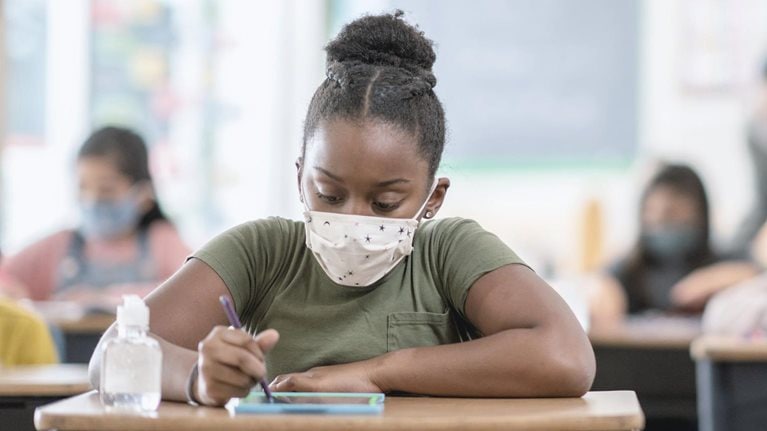K–12 schools in the United States have a limited window of opportunity to effectively spend pandemic-related stimulus dollars. The Elementary and Secondary School Emergency Relief Fund (ESSER)1 allocates $190 billion in federal funding to the nation’s schools—an amount equal to roughly a quarter of the annual K–12 budget of $795 billion.2 ESSER is the largest single federal investment ever in primary and secondary education and provides roughly double what schools received under the American Recovery and Reinvestment Act (ARRA) of 2009.3 But the funds must be fully obligated by September 2024, meaning the clock is ticking for districts to make the most of this opportunity.
School districts around the nation are wrestling with pressing issues largely stemming from the pandemic, including declining enrollments, COVID-19-related learning delays,4 and a growing student mental-health crisis.5 When allocating ESSER funding, districts are struggling to balance the immediate need to address these issues with longer-term priorities and investments, including those that were underfunded prior to the pandemic.
To gain a greater understanding of district budget priorities and the challenges school systems have faced in deploying ESSER funding to date, McKinsey surveyed 260 district decision makers, including superintendents, assistant superintendents, chief business officers, and chief technology officers (see sidebar “Survey methodology”).
The survey revealed that more than 90 percent of district administrators have faced challenges deploying stimulus funds effectively. By the end of the 2021–22 school year—halfway through the available funding window—districts had spent an estimated $45 billion of total available funds. That leaves approximately $130 billion to allocate over the next three budget cycles, increasing districts’ near-term annual budgets by approximately 5 to 6 percent. Based on these findings, McKinsey projects that nearly $20 billion in ESSER funds may not be obligated by the deadline because of a variety of factors, including administrative hurdles, limited internal planning capacity, and talent and vendor shortages.
As districts look ahead, their priorities are shifting from immediate pandemic response and safety measures to addressing unfinished learning and persistent staffing challenges—interventions that may be harder to implement and scale. Moreover, the looming prospect of a “fiscal cliff” when the stimulus funding expires, along with longer-term declining enrollment trends, could create financial challenges for some districts down the road.
Drawing on McKinsey’s survey, this article provides insights into the size and scope of the challenges districts face when deploying ESSER funds and offers a framework that could help them make the most of this opportunity for the students they serve.
Headwinds in spending ESSER funds to date
More than 90 percent of ESSER funds flow directly to local education agencies (LEAs), primarily education districts, proportional to Title I grant allocations.6McKinsey’s survey found that districts have faced three major challenges deploying funds thus far: administrative hurdles, talent shortages, and insufficient strategic planning and operational capacity (Exhibit 1).

Nearly three-quarters of district administrators said they had struggled to overcome administrative hurdles to receiving funds, navigating compliance, and finalizing procurement. To get approval, districts must submit plans to their state education agency (SEA) and show that these meet the standards of evidence defined in the Every Student Succeeds Act.7 But the act is open to interpretation, and states are balancing a desire to get funding out the door quickly with a need to minimize the risk of federal audits down the road.
More than 61 percent of district administrators said talent shortages, both in staffing and in sourcing quality vendors and suppliers, were an issue. Demand for teachers, tutors, mental-health professionals, and classified staff is outstripping supply. Increases in new positions due to federal stimulus funding as well as ongoing pandemic disruptions and resignations are exacerbating this human capital shortage. And 53 percent of districts said they were struggling to assemble the internal strategic-planning and operational capacity to make and execute spending decisions in the face of competing priorities and ongoing disruptions.
The upshot: ESSER funds could be left on the table.8 Based on our survey results, we estimate that by the end of the 2021–22 school year, districts had spent less than a quarter of the total ESSER funding available, with about a third of funding neither budgeted nor spent. This suggests that unless the pace of planning and spending picks up, nearly $20 billion could remain unused by school districts (Exhibit 2). These are funds that could be channeled to address the serious challenges that schools are facing as they recover from the pandemic and prepare students for an increasingly automated workplace.9

Evolving district priorities over the next three years
Over the next three school years, district administrators expect their overall funding levels to grow by about 5 to 7 percent per year. While there will be more money to spend across many areas, priorities are shifting. Our survey asked district administrators about historical spending trends and future expectations across 35 categories spanning teacher recruitment, compensation and training, instructional programs, administration, student support and technology, and facilities and infrastructure (Exhibit 3).

In the first three years of pandemic schooling (2019–20, 2020–21, and 2021–22), districts prioritized pandemic-related safety concerns and support for vulnerable students through the crisis. The fastest-growing spending categories included upgrading heating, ventilation, and air conditioning (HVAC) systems; increasing compensation for substitute teachers; recruiting teachers to backfill shortages; providing students with devices during remote learning; and tackling new construction, mostly related to COVID-19 readiness.
Over the next three school years (2022–23, 2023–24, and 2024–25), districts expect to shift more funding toward addressing unfinished learning and persistent staffing challenges. Substitute-teacher compensation is projected to remain in the top five fastest-growing spending categories. Other top categories are expected to include tutoring programs, teacher training and professional development, compensation for special-education teachers, and credit recovery to provide students who have failed a class the opportunity to make up missed credits.
We identified four segments of spending with differing growth trajectories as district priorities evolve: continued-learning imperatives, emerging district priorities, pandemic priorities, and baseline priorities (Exhibit 4).

Continued-learning imperatives are durable priorities across the early pandemic years and through the remainder of the stimulus period. Many teacher-related issues fall within this area as districts continue to wrestle with teacher shortages and declining job satisfaction. Some districts have launched ambitious hiring programs to add more teachers to their rosters. But these new open positions may be exacerbating shortages elsewhere, especially in historically hard-to-fill areas such as science, technology, engineering, and mathematics (STEM) fields; rural schools; and high-poverty urban schools. Districts everywhere are struggling to fill substitute-teacher roles, leading to increases in substitute pay by almost 20 percent on average since 2020.10
Meanwhile, some districts are investing in developing and supporting their existing teaching staff. For example, during the 2022–23 school year Chicago Public Schools is investing $45 million in professional development—its largest area of investment.11 Other school districts are investing in teacher productivity tools to reduce the administrative burden on teachers and support retention efforts. For example, in the Orange Unified School District in California, investments in single-sign-on technologies saved instructors a reported 2,500 hours of instruction time per month.12
Beyond teachers and teaching, the pandemic also highlighted the importance of food and nutrition services, elevated the role of parents in their children’s education,13 and made one-to-one student device access at school and at home a necessity. Spending on these categories is forecast to keep growing through the 2024–25 school year.
Emerging district priorities are areas in which spending is expected to accelerate over the next three years.These interventions are largely focused on addressing the impact of the pandemic on student learning and well-being. The success of high-dosage tutoring programs in supporting students to accelerate learning has been well documented, and expanded resources are now available to districts looking to set up their own tutoring programs or partner with existing providers.14 Spending on intervention curricula and credit recovery is also expected to rise significantly to support students in accelerating learning.
Student behavioral and mental health is another area that is likely to see spending growth, reflecting a rising mental-health crisis among young people that the COVID-19 pandemic has exacerbated.15 Some states and districts are responding with increased investments, but many districts that recognize the growing need for more student mental-health services are not currently equipped with the personnel and resources to provide this support. Moreover, shortages of qualified school counselors and psychologists are making it difficult to ramp up services quickly.
Spending on some pandemic and baseline priorities is also forecast to increase over the next three years, though not as robustly as other areas. While many districts were able to invest in HVAC and new construction during the pandemic, the long cycle times and supply chain challenges associated with these projects delayed others. Recent Department of Education letters suggest that the liquidation window for approved projects may be extended up to 18 months for school infrastructure projects and up to 14 months for other expenditures via specific extension requests,16 a development that could persuade some districts to move funding towards these expenditures.
Spending on virtual schooling is also set to grow more slowly, with students gradually shifting back to in-person learning. However, the portion of students likely to learn virtually remains significantly higher than before the pandemic, and many more districts are set to continue offering virtual- or hybrid-school options. Many educational-technology investments also sit in this slower-growth category, including core administration technologies such as student information systems and learning management systems, as well as more innovative approaches such as augmented reality or virtual reality (AR/VR) and the metaverse. While this latter technology is still in its infancy in K–12 education, and therefore mostly unproven, experiments are proliferating given the falling costs of hardware. And there is some early evidence that these technologies may increase student engagement and retention.17 Milwaukee Public Schools, for example, revised its May 2022 budget plan to allocate approximately $12 million for essential instructional technology. This included classroom VR kits to create content and $1 million for VR equipment for STEM classes.18
There are also areas where less additional spending is anticipated. For example, fewer districts anticipate large spending increases on summer school and after-school learning, despite relatively promising evidence indicating that well-designed programs can be effective at advancing student learning.19 Similarly, fewer districts anticipate meaningful additional spending on extensions to the school day or school year.
Some initiatives that will be the hardest to implement are those for which the pace of spending is forecast to increase the fastest. Purchasing new curricula, technology, or devices requires thorough research, and embarking on new construction is time-consuming, but there are proven processes that can help, and supply is generally adequate to meet demand. By contrast, investing in human capital–intensive programs, especially those that have never been attempted at scale, could create challenges that are difficult to navigate. Moreover, this is happening at a time when talent shortages are affecting most sectors of the US economy. School districts across the nation are looking to hire more teachers, more tutors, and more mental-health professionals in the context of tight labor markets and long certification cycles. This may further undermine the ability of districts to successfully deploy ESSER funding by the deadline.
Longer-term uncertainty on funding and enrollment
While districts expect an influx of funds and spending in the near term, what happens when the federal stimulus funds run out is open to question. Many education reform experts have warned of an impending fiscal cliff, requiring painful cuts and possibly layoffs. Not only is ESSER funding set to end in 2024, but school budgets are under pressure from other sources, including public-school enrollment declines,20 growing inflation, and the looming specter of recession.21 These trends are likely to affect some districts and states more than others: enrollment declines were projected in some Northeastern states prior to the pandemic because of ongoing demographic trends.22
Many of the district administrators we surveyed remained relatively sanguine despite these potential challenges. Only one in five district administrators said they were “very worried” about a fiscal cliff affecting budgets in the 2025–26 school year. District leaders cited multiple reasons for this perspective. While enrollment in public schools dipped during the pandemic, hold-harmless clauses protected many school districts from the falling revenues these decreases would otherwise have caused (given that most funding is generally allocated on a per-student basis). And district administrators expected that students who had opted for private schools or homeschooling during the pandemic would return to public schools between 2022 and 2024 as schools resumed in-person learning and dropped mask and quarantine requirements. More than half of district administrators also expected spending to be “sticky.” In other words, they anticipated that federal funding programs would be extended, replaced by new federal funding or supplemented by philanthropic funding.
Despite districts’ general optimism, they could still benefit from thoughtful contingency planning should the outlook darken.
Realizing the potential of ESSER
Though the window for action is narrowing, there is sufficient time to ensure remaining ESSER funds are strategically allocated toward priorities that will improve student outcomes by addressing immediate learning delays as well as long-standing challenges and opportunity gaps. A three-step approach could help districts to plan and implement.
Districts can start by performing a rapid diagnostic to evaluate the impact of existing ESSER investments and identify what is working and where roadblocks impeded progress—and why. For example, districts could determine whether critical milestones were met and how their efforts are (or aren’t) beginning to translate into improved student learning and well-being. Informed by an understanding of where progress is being made, districts can then lay out potential next steps: which initiatives could be expanded given remaining funds, which may need to be adjusted to improve impact, which can be maintained as is, and which may need to be deprioritized.
Second, districts could develop potential new initiatives as needed to fill gaps and allocate remaining funds. In this process, districts can draw upon multiple sources, including the existing evidence base on improving student learning and well-being,23 practices from other peer districts, and community-generated ideas from principals, schools, and families.
Third, districts can step back to reexamine the full portfolio of ideas against a set of agreed criteria, such as meeting evidence-based standards, the likely impact on student outcomes, and the timeline for, and feasibility of, implementation. Districts can think beyond the two-year time frame, prioritizing investments in which money can be spent now that will build toward the future and reimagining elements of their education strategy and delivery to better meet students’ evolving needs.24 As part of this process, districts could consider delegating some portion of funding decisions directly to schools, tracking the impact of school-led initiatives.25
Districts may want to remain cognizant of the potential for a fiscal cliff, especially if their enrollment is down or if hold-harmless provisions are expiring. For example, districts could proactively identify current efforts that might need to be discontinued, scaled back to a subset of the current students served, or redesigned in more cost-effective ways while maintaining fidelity. Once the priorities are set, the work is just beginning. Districts can use best-practice strategies for implementation, procurement, and performance management to ensure funds are spent—and in a way that most benefits students.
Finally, districts need not go it alone. They can learn both from established peer networks and new ESSER-specific communities of practice. And the philanthropic and private sectors could also help districts use these funds more effectively and by the ESSER deadline (see sidebar “What can philanthropic and private sectors do to support districts?”).
The remaining $130 billion in federal stimulus funding for K–12 education presents challenges and opportunities for school districts across the United States. While addressing unfinished learning and teacher shortages is a clear priority, the size of the stimulus enables districts to invest in other priorities, from food and nutrition and parent communication to high-tech learning tools such as virtual reality. The challenge is not only to spend ESSER funds within the mandated deadline but also to ensure these investments have the greatest possible impact on student learning and well-being.


